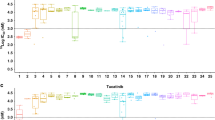Abstract
Purpose. Previous studies have demonstrated enhanced potency associated with the binary [DNA/epidermal growth factor receptor (EGFR)] targeting properties of SMA41 (a chimeric 3-(alkyl)-1,2,3-triazene linked to a 4-anilinoquinazoline backbone) in the A431 (epidermal carcinoma of the vulva) cell line. We now report on the dependence of its antiproliferative effects (e.g. DNA damage, cell survival) on the EGFR and the DNA repair protein O6-alkylguanine DNA alkyltransferase (AGT) contents of 12 solid tumor cell lines, two of which, NIH3T3 and NIH3T3 HER14 (engineered to overexpress EGFR), were isogenic.
Methods. Receptor type specificity was determined using ELISA for competitive binding, as well as growth factor-stimulation assays. DNA damage was studied using single-cell microelectrophoresis (comet) assays, and levels of EGFR were determined by Western blotting. The effects of SMA41 on the cell cycle of NIH3T3 cells were investigated using univariate flow cytometry.
Results. Studies of receptor type specificity showed that SMA41: (a) preferentially inhibited the kinase activity of EGFR over those of Src, insulin receptor and protein kinase C (PKC, a serine/threonine kinase), (b) induced stronger inhibition of growth stimulated with EGF than of growth stimulated with platelet-derived growth factor (PDGF) or fetal bovine serum (FBS). Despite the EGFR specificity of SMA41, there was an absence of a linear correlation between the EGFR status of our solid tumor cell lines and levels of DNA damage induced by the alkylating component. Similarly, EGFR levels did not correlate with IC50 values. The antiproliferative activities of SMA41 correlated more with the AGT status of these cells and paralleled those of the clinical triazene temozolomide (TEM). However, throughout the panel, tumor cell sensitivity to SMA41 was consistently stronger than to its closest analogue TEM. Experiments performed with the isogenic cells showed that SMA41 was capable of inducing twofold higher levels of DNA damage in the EGFR transfectant and delayed cell entry to G2/M in both cell types. When the cells were starved and growth-stimulated with FBS (conditions under which both cell types were growth-stimulated), in contrast to TEM, SMA41 and its hydrolytic metabolite SMA52 exhibited approximately nine- and threefold stronger inhibition of growth of the EGFR transfectant.
Conclusions. These results suggest that, in addition to its ability to induce DNA damage and cell cycle perturbations, SMA41 is capable of selectively targeting the cells with a growth advantage conferred by EGFR transfection. When compared with the monoalkyltriazene prodrug TEM, its potency may be further enhanced by its ability to hydrolyze to another signal transduction inhibitor (SMA52) plus a DNA alkylating agent that may further contribute to chemosensitivity. Thus, our new "combi-targeting" strategy may well represent a tandem approach to selectively blocking receptor tyrosine kinase-mediated growth signaling while inducing significant levels of cytotoxic DNA lesions in refractory tumors.
Similar content being viewed by others

Author information
Authors and Affiliations
Additional information
Electronic Publication
Rights and permissions
About this article
Cite this article
Matheson, S.L., McNamee, J.P. & Jean-Claude, B.J. Differential responses of EGFR-/AGT-expressing cells to the "combi-triazene" SMA41. Cancer Chemother Pharmacol 51, 11–20 (2003). https://doi.org/10.1007/s00280-002-0525-4
Received:
Accepted:
Issue Date:
DOI: https://doi.org/10.1007/s00280-002-0525-4



